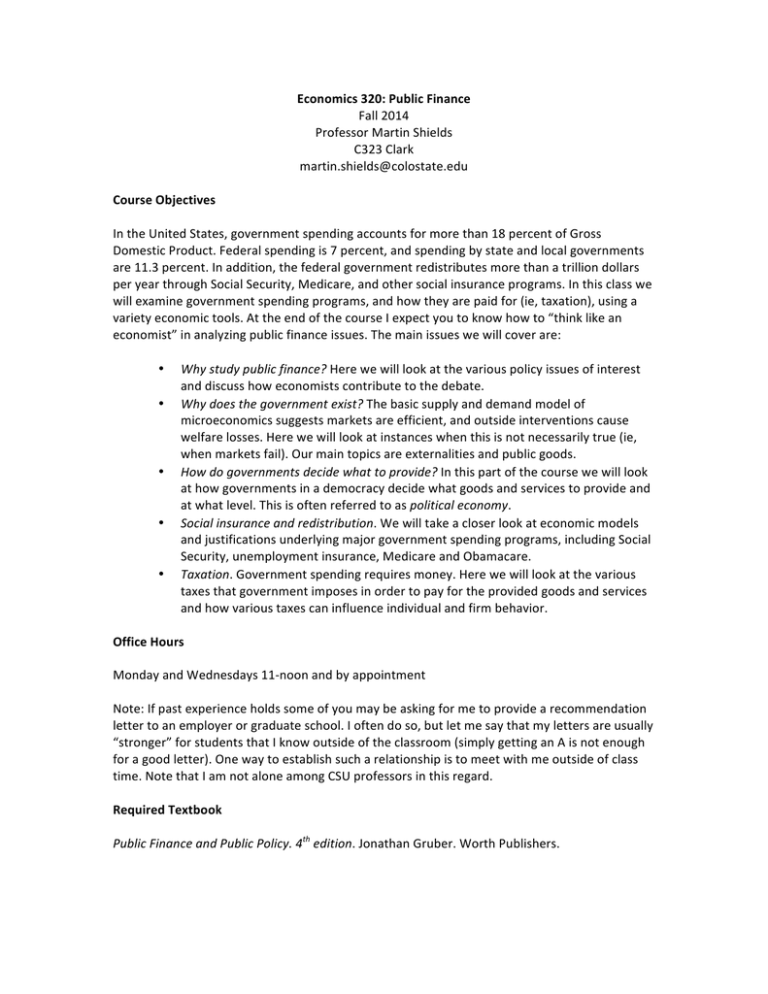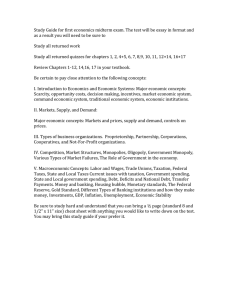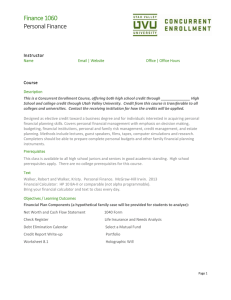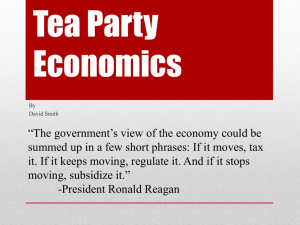Document 12777937
advertisement

Economics 320: Public Finance Fall 2014 Professor Martin Shields C323 Clark martin.shields@colostate.edu Course Objectives In the United States, government spending accounts for more than 18 percent of Gross Domestic Product. Federal spending is 7 percent, and spending by state and local governments are 11.3 percent. In addition, the federal government redistributes more than a trillion dollars per year through Social Security, Medicare, and other social insurance programs. In this class we will examine government spending programs, and how they are paid for (ie, taxation), using a variety economic tools. At the end of the course I expect you to know how to “think like an economist” in analyzing public finance issues. The main issues we will cover are: • Why study public finance? Here we will look at the various policy issues of interest and discuss how economists contribute to the debate. • Why does the government exist? The basic supply and demand model of microeconomics suggests markets are efficient, and outside interventions cause welfare losses. Here we will look at instances when this is not necessarily true (ie, when markets fail). Our main topics are externalities and public goods. • How do governments decide what to provide? In this part of the course we will look at how governments in a democracy decide what goods and services to provide and at what level. This is often referred to as political economy. • Social insurance and redistribution. We will take a closer look at economic models and justifications underlying major government spending programs, including Social Security, unemployment insurance, Medicare and Obamacare. • Taxation. Government spending requires money. Here we will look at the various taxes that government imposes in order to pay for the provided goods and services and how various taxes can influence individual and firm behavior. Office Hours Monday and Wednesdays 11-­‐noon and by appointment Note: If past experience holds some of you may be asking for me to provide a recommendation letter to an employer or graduate school. I often do so, but let me say that my letters are usually “stronger” for students that I know outside of the classroom (simply getting an A is not enough for a good letter). One way to establish such a relationship is to meet with me outside of class time. Note that I am not alone among CSU professors in this regard. Required Textbook Public Finance and Public Policy. 4th edition. Jonathan Gruber. Worth Publishers. Course Outline This is the general plan for the semester. The timing may change for the materials, as we may get through some sections either faster or slower. The exam and assignment dates, however, are fixed. I will post relevant supplementary materials on RamCT. Check it frequently. Week Topics Chapters Assignment and due date 8.25 Course overview 1,4 Why study public finance? Budget analysis and deficit financing 9.1 Theoretical tools of public finance 2,3 Empirical tools of public finance (brief) 9.8 Externalities 5,6 PS1 due 9.11 9.15 Public goods 7 9.22 Cost-­‐Benefit analysis 8,9 PS2 due 9.25 Political economy 9.29 Political economy 9 EXAM 1 9.30 10.6 State and local government expenditures 10,11 PS3 due 10.9 Education 10.13 Social insurance 12,14 Unemployment & disability insurance 10.20 Social Security 13 PS4 due 10.23 10.27 Health insurance 15 EXAM 2 10.28 11.3 Health insurance 16,17 Income distribution and welfare 11.10 Tax incidence and efficiency 18,19,20 PS5 due 11.13 11.17 Taxes on labor supply and savings 21,22 12.1 Taxes on risk taking and wealth 23 PS6 due 12.4 12.8 Corporate taxation and tax reform 24,25 Evaluation Your grade will be based on 3 in-­‐class, closed-­‐note and closed-­‐book exams (including the final) and 6 problem sets (PS). Calculators are permitted. Each exam will account for 20 percent of your grade. The exams will not be cumulative, and will strongly emphasize materials we cover in class. The problem sets are due in class on the date listed above. Late problem sets will suffer a 10 percent deduction each day that they are late. I will not use the plus/minus system. My grading scale is: A 89.0-­‐100.0 B 79.0-­‐88.99 C 69.0-­‐78.99 D 55.0-­‐68.99 If you expect to miss an exam, please let me be aware of that ASAP so we can find an alternative time. If you miss an exam due to a sudden health issue or an emergency, let me know as soon as you are able. In such instances, be prepared to provide an authorized reason for missing the exam. Students Requiring Special Accommodation If you need special accommodation please provide documentation from the office of Resources for Disabled Students (see http://rds.colostate.edu/). Attendance and Course Workload Attendance is not required, but is expected. If you do show up, your peers and I appreciate that you fully devote your attention the classroom, and that you do not disrupt our learning environment. Overall, students should expect to devote 8 hours per week to this class, including classroom time (2.5 hours). Expect to read 2 hours per week, study for another 2, with remaining time spent on problem sets. Academic Integrity This course will adhere to the Academic Integrity Policy of the General Catalog and the Student Conduct Code. The policy states: "Any student found responsible for having engaged in academic dishonesty will be subject to academic penalty and/or University disciplinary action." (General Catalog 2011-­‐2012, 1.6, p.8). Academic dishonesty in this course may result in a grade of "F" for the course and may be reported to the Office of Conflict Resolution and Student Conduct Services. Please be aware that the General Catalog specifically identifies the following examples of academic dishonesty: cheating in the classroom, plagiarism, unauthorized possession or disposition of academic materials, falsification, and facilitation of cases of academic dishonesty.




